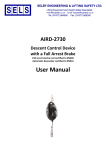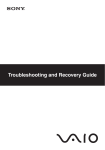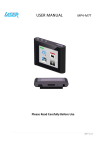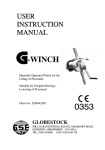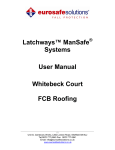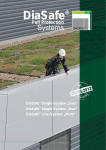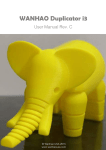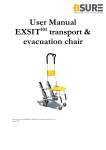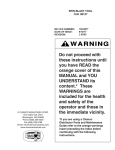Download RADD-2729 Evacuation & Rescue Device User Manual
Transcript
RADD-2729 Evacuation & Rescue Device User Manual Scope of Use The RADD-2729 was designed and manufactured as a single use evacuation device. The device retards a fall to a controlled descent of less than 2 metres per second. The product is suited to evacuation lowering to ground where safe rescue can be made or for evacuation from a point of hazard. The RADD-2729 can also be used as a rescue device to rescue a person suspended for example on a Fall Arrest Block. Storage Storage in a central protected location allows assurance of inspection on issue and return. This device should be stored in a clean dry place where it can be protected from damage by chemical attack, sharp objects and heat. It should be stored with its instructions and inspection record card at all times. After use, return to the store. Never leave a product lying around site. Issue This and associated equipment must be visually inspected by a competent person when initially delivered to site, thereafter the product must be inspected before and after use. An inspection record card is issued with this manual and should be updated after each routine inspection. Follow the points laid down in the section headed ‘Inspection’ without deviation. Persons should be issued with their own device for the duration of any working day it becomes their responsibility to ensure that RADD-2729 Descender is inspected before and cared for during use. Any problems or faults must be reported back to the supervisor immediately and before any use. The supervisor must ensure that the equipment is being used correctly and that the user is aware of its safe use and inspection. Additionally the supervisor must ensure that there are suitable and accessible anchorages in the working environment to allow safe tie off. Training should be provided prior to use. Inspection Particular attention must be paid to the following: Excessively soiled devices should be cleaned with a mild detergent and water and allowed to drip dry before inspection. Never immerse the device in soapy water to clean, use a damp cloth and allow the unit to dry Appearance – Ensure that the device is free of corrosion, and signs of abrasion, wear and cracks. Special attention should be given to the webbing. Check that the anchorage is sound and that it is also free of wear and damage. Function – Check that both the karabiner and the snap hook open and close freely. Lifeline – Look for damaged webbing unravelled threads or signs of abrasion. The life line should be stowed in its bag. Check for obvious signs of wear or misuse. If any feature shows cause for concern remove the unit from service immediately, mark the device as unserviceable and return to the supervisor. Never tamper with or attempt to service this unit. Device(s) must be returned to the manufacturer or their appointed agent for all maintenance. Frame – Check for damage to the steel frame, in particular inspect the cross bars to ensure they are not bent or distorted which would cause the webbing to snag. Installation Evacuation: In normal use it is recommended that the RADD-2729 is anchored from a structure that will hold a proof load of 10KN. However, in an emergency or rescue situation the RADD-2729 can be attached to a structure or anchor point that will hold a minimum static load of 3KN. The anchorage point should be robust and static. The anchorage should be positioned above the point of evacuation and the friction device tethered so that the user does not need to lean out to attach. Before descending check the area beneath for safe evacuation to make sure there are no dangerous objects or obstacles in the descent path. It is possible to traverse an object in the descent path by stopping the device and stepping to one side of the object before continuing the descent; if this is done you must make sure that the object you traverse does not interfere with the descender. There should be room about the path of descent that will allow the evacuee to swing on the device without injury. If the device is to be used where the evacuee has to swing out more than 30 degrees to be beneath the unit, then it is recommended that a Quick Release Anchor should be used with the unit which will allow the user to steady themselves before descending and the life line should be tethered within easy reach. If secured to a mobile platform or crane the user must ensure that there is not risk of toppling over if a person descends from the machinery. The device operates by webbing being pulled through a friction retarder which controls the descent speed. Once extended the device needs to be re packed and checked by an approved DCL person. Use The RADD-2729 is used with a Full Body Harness, Nappy, Sling or Chair and should only be attached to either an EN795 or suitable non engineered anchorage point. Before use, ensure that all checks and inspection have been completed in accordance with the section title Inspection’. Evacuation - Attach to the device by the hook or karabiner provided at the end of the life line. Check that the hook or karabiner is locked securely. Drop the bag or pouch holding the webbing to the ground. Once you have securely attached the RADD-2729 Descender to your harness, rescue strop, rescue cradle, or nappy and the snap hook has been attached to a secure anchor point. Before you descend ensure that the webbing has been fully deployed and has not snagged on any obstruction. Lower you over the edge ensuring that the device is kept under tension at all times, holding elbows in and knees together. Look down at the ground as you descend. When reaching floor level step forward and bend knees to cushion the force of impact. By holding the webbing as it leaves the bag the user can control their speed of descent or stop. Very little force is required there is no need to grab or clutch the webbing. Rescue – When used as a single person rescue device follow the instructions above for an evacuation device. The rescuer would have a short rescue strop which would have a karabiner or snap hook attached at each end. To rescue a person suspended on for example a Fall Arrest Block, the rescuer would attach the rescue strop to the front of their harness by means of a karabiner or snap hook before descending. On reaching the trapped person, the rescuer would attach the free end of the rescue strop by means of a karabiner or snap hook to an attachment point on the harness the person being rescued is wearing. The rescuer would check that both ends of the strop were secure and he would then, using a knife (which would be provided with the rescue kit) cut the Fall Arrest Block webbing attached to the person being rescued. The rescuer and rescuee would descend with the rescuer controlling the descent in the manner described above. Never work above the level of the device. Never tie off or restrict the free passage of life line from the bag. Always work directly below the device. Maximum/ Minimum Weight Limits Anchorages The supervisor must ensure that there are sufficient strong and accessible anchorage points in the working environment to ensure that all personnel can work safely. All anchorage points should be inspected regularly to ensure that they are robust and strong enough to withstand an impact load of 10kN (EN795). Only anchorages above head height should be used to attach to and the area beneath and around these anchorage points should be clear of obstruction and sharp edges. The user of the device should attempt to attach to an anchorage that is as close to the point of work and as high above head height as possible without restricting free movement. The user should be aware at all times of which point of attachment they should use. If this is not immediately obvious they should seek confirmation from the supervisor. Always ensure that the means of attachment to the anchorage is secure before moving off. Warning! Read and understand manufacturer’s instructions before inspection, installation or use of this product. • • • • • • Never use this product if you weigh more than 150 kg. If used in a rescue situation the combined weight of the two people descending should not exceed 200 kg Only use approved equipment with this product. If there are any points in this manual that you are unsure of, seek a competent trained person to advise you before using. Seek medical advice from a doctor before using this product if you have sustained a spinal injury, suffer from a neck or back complaint, or you are taking prescription medication. Never use if you are under the influence of alcohol or recreational drugs. Extra care should be taken if welding whilst using this product, protect the device and life line from splatter and heat at all times.





